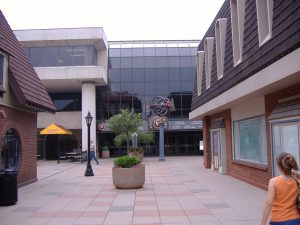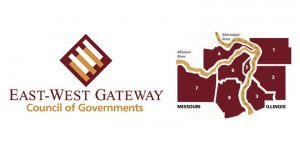East-West Regional planning seeks input on 2018 agenda
By Bob Pieper For Chronicle Media — March 22, 2017
The Great Streets Initiative, which began in 2006, is a redevelopment program intended to revitalize selected business districts and residential neighborhoods along sections of major roadways. (Photo courtesy of ewgateway.org)
A new Great Streets neighborhood redevelopment program in Metro-East, continuation of a major Mississippi River flood project program for the American Bottoms, and the first-ever color coded Air Quality Index for the bi-state St. Louis region are all proposed for next year in a draft 2018 St. Louis regional Unified Planning Work Program, released this month by the East-West Gateway Council of Governments (EWGCG).
The Unified Planning Work Program document outlines major initiatives proposed for federal funding across the eight-county greater St. Louis region next year.
The council is now requesting public comment on the draft The EWGCG is the federally-recognized regional planning entity charged with reviewing public works programs and related projects for which federal funding is sought.
The council began accepting public comment on the draft 2018 work plan on March 1, 2017. The public comment period closes April 14, 2017.
Launched by East-West Gateway in early 2006, the Great Streets Initiative is a redevelopment program intended to revitalize selected business districts and residential neighborhoods along sections of major roadways.
St. Louis’ Grand Avenue Arts District — home to the Fabulous Fox Theatre, the St. Louis Symphony and about a dozen other theatres and arts venues — is among the most high-profile examples of Great Streets projects.
Others include the redevelopment of a section of South Grand Avenue in St. Louis as a restaurant and shopping district and the Page Avenue retail and office development in the struggling North St. Louis County municipality of Pagedale.
Implicit in the Great Streets program is a challenge “to expand the way communities think of their streets,” according to the East-West Gateway website.
“Rather than viewing a roadway project as solely a way to move more cars and trucks faster, the goal of the St. Louis Great Streets Initiative is to trigger economic and social benefits by centering communities around interesting, lively and attractive streets that serve all modes of transportation.”
In most cases, Great Streets programs have centered around redeveloping declining retail districts as tourism or shopping destinations. However, the program also focuses on facilitating residential and additional business growth in surrounding areas, in part through development of “multimodal” transportation systems that encourage walking, biking and use of public transit.
 “Great Streets are representative of their places. A Great Street reflects the neighborhood through which it passes and has a scale and design appropriate to the character of the abutting properties and land uses,” the East-West Gateway website continues.
“Great Streets are representative of their places. A Great Street reflects the neighborhood through which it passes and has a scale and design appropriate to the character of the abutting properties and land uses,” the East-West Gateway website continues.
Great Street programs are developed through a citizen-based planning process known as a “charrette,” which centers around a series of public meetings.
In all, East-West Gateway has launch a dozen Great Streets projects along traffic corridors in the St. Louis region over the last 11 years. The council’s draft 2018 planning document calls for one Great Streets planning charrette in an Illinois community next year.
Several Metro-East Communities — including Alton, Granite City,Collinsville, East St. Louis, Fairview Heights, Columbia, and Belleville — are pursuing redevelopment of shopping districts.
One Great Streets program has already been launched in Metro-East. Main Street (Ill. 159) in Smithton was one of five corridors selected for studies in 2016 under the EWGCG’s fourth round of Great Street projects.
However, the draft EWGCG planning document does not indicate whether the Illinois Great Streets project, planned for next year, would center around completion of the Smithton project or a new project in Metro-East.
East-West Gateway officials did not respond to a message seeking clarification in time for this article.
In addition to the Great Streets project, the draft EWGCG planning document would also continue funding for a regional air quality coordination program covering both the Illinois and Missouri sides of the St. Louis area. The area currently fails to meet federal standards for particulates and ozone in the air. Heavy industry in Metro-East is often blamed.
The planning document calls for the council plans to begin posting to its website a color-coded Air Quality Index (AQI) calendar – reflecting for the first time data submitted by both the Missouri Environmental Protection Agency and Illinois Environmental Protection Agency.
The draft planning document would also continue funding for the management staff of the Southwestern Illinois Flood Prevention District, which is overseeing the reconstruction of the flood protection systems along the Mississippi River in the Illinois counties of Madison, St. Clair and Monroe.
Public comment on the 2018 Unified Planning Work Program can be submitted by contacting the East-West Gateway Council of Governments, One Memorial Dr., Ste 1600, St. Louis, MO 63102; Phone: (314) 421-4220 or (618) 274-2750; Fax: (314) 231-6120; E-mail: webmaster@ewgateway.org.
— East-West Regional planning seeks input on 2018 agenda —







